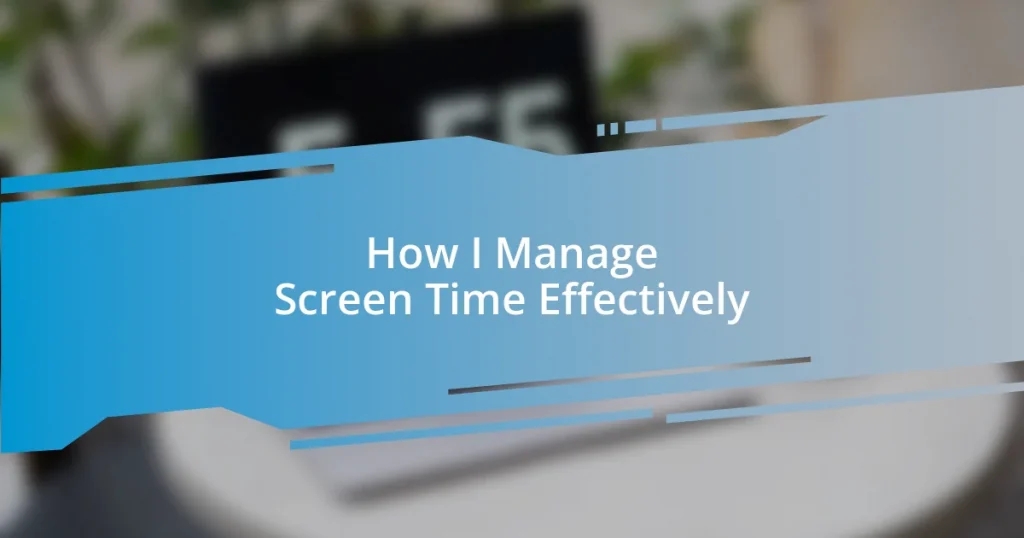Key takeaways:
- Recognizing the negative impacts of excessive screen time, including its effects on sleep and mental health, can drive positive changes in habits.
- Setting clear, structured screen time goals and monitoring daily usage promotes mindfulness and helps reclaim personal time for fulfilling activities.
- Engaging in offline activities, such as socializing, exploring nature, and pursuing hobbies, enhances well-being and reduces reliance on screens.

Understanding screen time impacts
When I first started paying attention to my screen time, I realized how intoxicating it could be. I found myself scrolling for hours, barely aware of the world around me. It made me wonder: how many precious moments do we lose, absorbed in a glowing screen instead of living in the present?
I also noticed that heavy screen time affected my sleep patterns. I used to binge-watch shows late at night, thinking I was just relaxing, but then I’d toss and turn for hours. The blue light from devices can mess with your circadian rhythm, leading to insomnia and fatigue. Have you ever felt drained after a full day of screen usage, only to realize it’s those late-night scrolls that are to blame?
Understanding how screen time impacts our mental health sparked a change in my habits. I began to feel the weight of anxiety increase as I compared my life with the highlight reels of others online. It hit me that while technology connects us, it can also create feelings of isolation and inadequacy. Reflecting on my experiences, I see now that moderation is essential for my emotional well-being.

Setting clear screen time goals
Setting clear screen time goals has been a game changer for me. Initially, it felt overwhelming to dial back my usage, but I took it one step at a time. I set specific limits—like no screens an hour before bed or reducing social media time to 30 minutes a day. These targets not only helped me reclaim my time but also improved my overall mood.
One approach that worked well was writing down my goals in a visible place. The act of seeing those goals reminded me of my commitment to reduce my screen time. It became almost like a personal contract. Whenever I felt the pull of my phone, those tangible goals helped me pause and reflect, leading to a satisfying sense of accomplishment. Have you ever tried writing down your goals? I found that it keeps the intention fresh in my mind.
Incorporating the SMART framework—Specific, Measurable, Achievable, Relevant, Time-bound—has further guided my screen time objectives. For example, instead of a vague goal like “watch less TV,” I shifted to “limit TV to two episodes on weekdays.” This clarity not only reduced my screen time but also ensured I had quality moments to engage in other activities. Seeing real progress fueled my motivation, reinforcing the positive impact of setting clear goals.
| Goal Type | Example |
|---|---|
| Daily Limit | No screens after 8 PM |
| Weekly Challenge | 30 minutes of social media daily |

Monitoring daily screen time usage
Monitoring daily screen time usage has become an integral part of my life. At first, I relied on built-in features on my devices, like screen time trackers, to see how much I was actually using them. Discovering that I was often using my phone for upwards of five hours a day was a bit of a wake-up call; I hadn’t realized how quickly those minutes added up. This simple act of observation helped me develop a greater awareness of my habits and sparked my desire to change.
To keep this awareness fresh, I’ve started tracking my daily usage in a journal. It’s a quirky, albeit effective, way to reflect on how I spend my time. Here’s what I usually jot down:
- Total screen time for the day
- Breakdown of apps used (social media, gaming, streaming, etc.)
- Noteworthy moments when I felt the urge to check my phone
- How I felt after various sessions (focused, distracted, anxious)
By noting these details, I’ve realized that some of the most fulfilling parts of my day occurred when I consciously chose to be screen-free, whether it was engaging in a hobby or reading a book. This ongoing dialogue with myself encourages a healthier relationship with technology, allowing me to prioritize real-life moments over virtual scrolling.

Creating engaging offline activities
Finding engaging offline activities can be a delightful challenge, yet immensely rewarding. I once struggled to think of alternatives to screen time until I rediscovered the joy of board games. Organizing a game night with friends transformed my weekends; those evenings were filled with laughter, competition, and genuine connections—far more fulfilling than a series binge-watching session. Have you ever noticed how the energy in a room shifts when everyone puts their screens down?
Another activity that has sparked my creativity is exploring nature. On weekends, I began taking short hikes in nearby parks. The fresh air and the sounds of chirping birds have a way of melting away daily stress. I was surprised at how just being in nature recharged my mind. It made me realize that stepping away from screens could lead to experiences that not only refresh me but also inspire my creativity. What’s your favorite way to connect with the great outdoors?
To keep those offline moments vibrant, I’ve also started participating in local community activities, like pottery classes. I remember the first time I shaped a lump of clay—it felt therapeutic and liberating. This hands-on engagement brings a sense of achievement that screens simply can’t replicate. The camaraderie built while learning new skills makes the entire process delightful. What activities do you think could bring more fulfillment to your life? You might find yourself exploring new passions that not only limit screen time but enrich your daily experience.

Implementing screen time limits
Setting screen time limits has been a game changer for me. I remember the first time I decided to implement a daily limit on my social media usage to just 30 minutes. At first, it felt restrictive, but as I adjusted, I found my evenings opened up to activities I actually enjoyed, like playing guitar or cooking new recipes. Have you ever felt that rush of satisfaction when you complete a task you’ve been putting off simply because you weren’t scrolling?
To make this transition smoother, I’ve learned to use timers effectively. I set reminders on my devices to gently nudge me when the designated time is up. It’s surprising how that little bit of structure can help me resist the urge to dive back in. I recall one evening when my timer went off while I was three episodes deep into a show—rather than simply dismissing it, I took a breath and opted to read instead. That night, I ended up engrossed in a riveting novel and went to bed more fulfilled than I had in weeks.
Incorporating these limits has not only improved my mental clarity but also fostered a sense of autonomy over my time. I’ve replaced the anxiety of constantly checking notifications with mindfulness about how I choose to spend my hours. Each time I stick to my limits, I feel more in control. Isn’t it empowering to realize that we can reclaim our time? Embracing structure doesn’t have to feel like a punishment; it can open the doorway to new passions and deeper connections with ourselves and others.
















